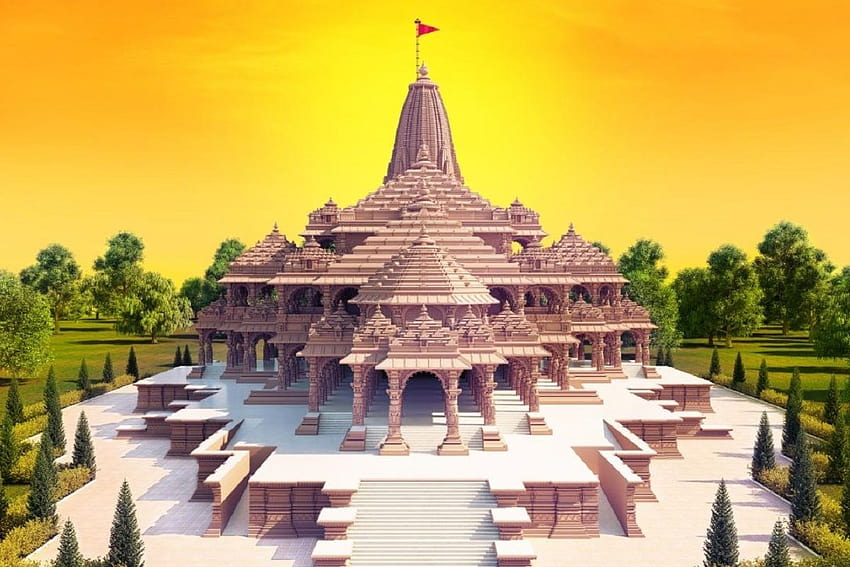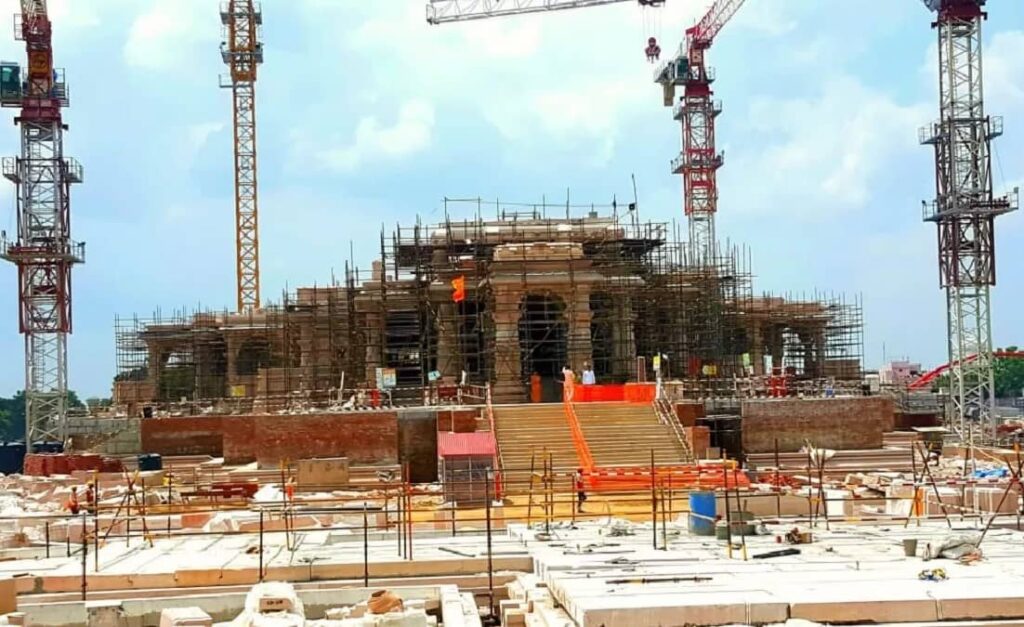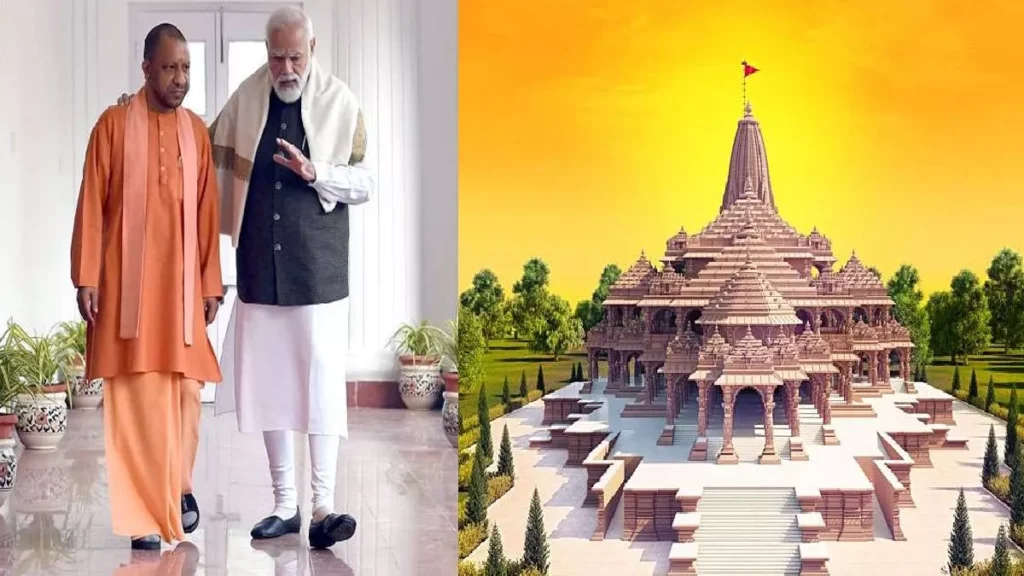In Ayodhya, Uttar Pradesh, India, there is a Hindu shrine called the Ram Mandir. It is situated at the supposed birthplace of Hinduism’s foremost deity, Rama, known as Ram Janmabhoomi. In Ayodhya, Uttar Pradesh, India, there is a Hindu shrine called the Ayodhya Ram Mandir. It is situated at the supposed birthplace of Hinduism’s foremost deity, Rama, known as Ram Janmabhoomi.

Prime Minister Narendra Modi conducted the bhumi pujan, or “ground breaking ceremony,” to officially launch the construction of Ayodhya Ram Mandir on August 5, 2020. Under the supervision of the Shri Ram Janmabhoomi Teerth Kshetra Trust, the temple is being built. The temple’s prana pratishtha, or dedication, is set for January 22, 2024. Built in the sixteenth century CE, the site was once home to the Babri Masjid. Muslims will receive land elsewhere, and Hindus would receive the contested site for the construction of a temple, according to a 2019 Supreme Court of India ruling. The Archaeological Survey of India (ASI) report that suggested the existence of a non-Islamic structure beneath the now-demolished Babri Masjid was used by the court as evidence.
History
Ancient and Mediaeval
A Hindu god, Rama is an avatar of Vishnu. Rama was born in Ayodhya, so the ancient Indian epic Ramayana says.
Babur is thought to have assaulted and destroyed the temple during his series of raids on temples throughout northern India in the sixteenth century. Subsequently, the Ram Janmabhoomi, the location of Rama’s birth, is thought to be the Babri Masjid, a mosque built by the Mughals.Joseph Tiefenthaler, a Jesuit missionary, wrote the Latin book Descriptio Indiae in 1767, which contains the oldest known mention of the mosque. He said that the mosque was built by demolishing the Bedi, which is home to Rama’s birthplace, and the Ramkot temple, which is thought to be the fortification of Rama in Ayodhya.
Modern
Following the installation of the murtis, or sacred pictures, of Rama and Sita within the Babri Masjid on the evening of December 22–23, 1949, the devotees started to congregate the following day. By 1950, the mosque was under state authority under section 145 CrPC, and Hindus, not Muslims, were permitted to pray there.
An estimated 2,000 people died as a direct result of the demolition of the mosque, which set off riots across the Indian subcontinent and several months of intercommunal violence between the Hindu and Muslim communities in India. On December 7, 1992, a day after the mosque was demolished, The New York Times revealed that more than thirty Hindu temples in Pakistan had been targeted, some of which set on fire, and one was demolished. Hindu temples in Bangladesh were also attacked.
Architecture
Design:
- The original design for Ayodhya Ram Mandir was created in 1988 by the Ahmedabad-based Sompura family. The Sompuras have designed over 100 temples worldwide, including the Somnath temple, for at least 15 generations. Chandrakant Sompura was the chief architect of the temple, assisted by his two sons, Nikhil and Ashish Sompura, who are also architects.

- The Vastu and Shilpa shastras, two Hindu texts, state that the Sompuras devised a new design in 2020, but it differed slightly from the original. The temple will have dimensions of 76 metres (250 feet) in width, 120 metres (380 feet) in length, and 49 metres (161 feet) in height. Once completed, the complex will be the third largest Hindu temple in the world. The Chaulukya-Gurjara the architectural style that was employed in its construction is the Nagara architectural style, which is primarily found in northern India. A replica of the projected temple was on display in 2019 at the Prayag Kumbh Mela.
- There will be 366 columns in all on the building. The ten Dashavataras, the twelve incarnations of the goddess Saraswati, the 64 Chausath Yoginis, and the avatars of Shiva will all be represented by 16 idols apiece in the columns. The steps will have a width of 16 feet, or 4.9 metres. According to texts on the architecture of Vishnu temples, the sanctum sanctorum will have eight sides. Ten acres (0.040 km2) will be used to construct the temple, and an additional 57 acres (0.23 km2) will be turned into a complex that will have a museum, restaurant, prayer hall, lecture hall, and educational centre.
- Sandstone from Baansi in Rajasthan, weighing 17,000 m3 (or 600,000 cu ft), will be used to complete the construction project. The temple will be built without the use of iron, and 10,000 copper plates will be used to fuse the stone blocks together. Thailand is also making a culturally significant symbolic contribution to the opening of the Ram Mandir by providing soil to the Ram Janmabhoomi. This builds on their previous act of honouring the temple by sending water from two Thai rivers.
Construction

First Phase of Ayodhya Ram Mandir
- The first phase of the Ayodhya Ram Mandir’s construction was initiated in March 2020 by the Shri Ram Janmabhoomi Teerth Kshetra trust. The Covid-19 pandemic shutdown in India caused the building to be temporarily suspended. The temporary transfer of Ram’s idol was witnessed by Uttar Pradesh Chief Minister Yogi Adityanath on March 25, 2020. Prior to the building of the temple, the Vishwa Hindu Parishad (VHP) organised a “Vijay Mahamantra Jaap Anushthan”. People would gather to recite the “Vijay Mahamantra,” which is Shri Ram, Jai Ram, Jai Jai Ram, at different sites on April 6, 2020. It was said that by doing this, “victory over hurdles” would be ensured during the temple’s construction.
- Champat Rai, the General Secretary of the Sri Ram Janmbhoomi Kshetra Trust, has officially announced that January 22, 2024 is the day that the Rama idol will be placed in the sanctum sanctorum, or garbhagriha. Prime Minister Narendra Modi was formally invited to the function on October 25, 2023.
Bhumi Pujan ceremony
- Following a Bhumi-Pujan (literally, “ground breaking ceremony”) on August 5, 2020, the temple’s construction formally resumed. Prior to the groundbreaking ceremony, which saw Prime Minister Narendra Modi laying a 40 kilogramme (88 lb) silver block as the foundation stone, a three-day Vedic ritual was conducted. The Ramarchan Puja, or “Puja of Rama’s feet,” was performed the day before on August 4 in order to formally invite all of the major deities into the temple.
- At the Hanuman Garhi Temple in Ayodhya on August 5, Prime Minister Narendra Modi prayed to obtain Hanuman’s blessings for the day’s activities. This was followed by the groundbreaking ceremony for Ram Mandir. Speaking were Yogi Adityanath, the Chief Minister of Uttar Pradesh, Mohan Bhagwat, the Chief of the Rashtriya Swayamsevak Sangh (RSS), Chief of the Ram Janmabhoomi Nyas, Chief of the Shri Ram Janmabhoomi Teerth Kshetra, Nritya Gopal Das, and Narendra Modi.
- The Bharatiya Janata Party’s politicisation of the temple, the alleged misuse of donations, and the exclusion of some of its most prominent workers have all contributed to the temple’s controversy.
